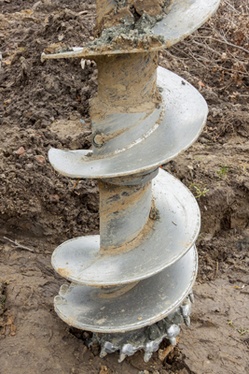The environmental drilling techniques used in Texas can vary greatly. It depends heavily on the project's purpose and the location of the jobsite.
Air Rotary Drilling
The air rotary drilling technique uses a bit to grind away in the borehole. The air pulls the cuttings up from the bottom and out of the way of the bit. Direct air rotary drilling and reverse air drilling are the most common types. This method penetrates the ground quickly and can penetrate hard formations easily.
Air rotary drilling is good for setting monitoring wells at specified layers as well as taking good representative samples of soil at different layers. It is not the best method, however, for sandy soils since the borehole sides tend to wear away in the wash of air.
Mud Rotary Drilling
Mud rotary drilling works much the same as air rotary drilling. The main difference is that instead of using air to remove the drill cuttings, the system uses water or another liquid medium to remove the cuttings. The system filters out the cuttings at the surface and circulates the liquid back into the hole.
This method of drilling works well in all kinds of soil, including sandy ones. The wearing that air creates is not a problem with mud rotary drilling. However, the drilling crew has to capture and dispose of the waste water used in the drilling process.
Hollow Stem Auger Drilling
When sampling is needed at shallow depths in softer formations, hollow stem auger drilling can be a good choice. The tip of the drilling equipment has a point that digs into the formation below. The cuttings travel up the spiraling wings of the stem. Once the drill reaches a given level, sampling can happen through the hollow stem.
While auger drilling is slower than rotary drilling, it does allow for quick sampling as there is no need to remove the auger. If the auger encounters saturated sand, the sand can come up the stem and cause issues.
Direct Push Drilling
Taking a profile of the soil substructure requires clean sampling. Direct push drilling is ideal. This kind of drilling uses percussion force to drive steel boring rods deep into the soil. The drilling crews can take samples of groundwater, soil, and soil gas. It is possible to use probes on the rods to take readings.
This method of drilling is quick and inexpensive. The limits are depth, hard formations, and large bore width needs.
If you need environmental drilling done, give Talon/LPE Drlling Services a call. We have decades of experience drilling in all the landscapes of the state.

